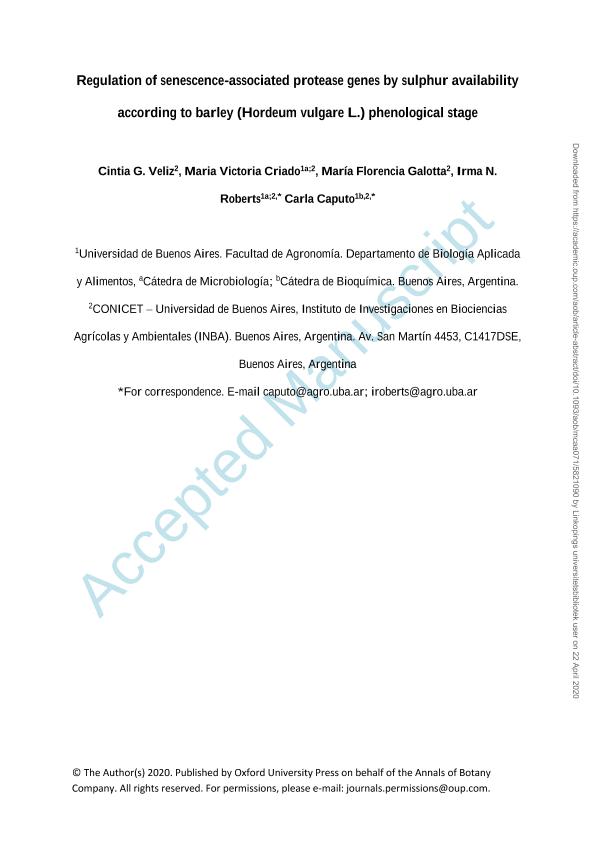Artículo
Regulation of senescence-associated protease genes by sulphur availability according to barley (Hordeum vulgare L.) phenological stage
Veliz, Cintia Gabriela ; Criado, Maria Victoria
; Criado, Maria Victoria ; Galotta, María Florencia
; Galotta, María Florencia ; Roberts, Irma
; Roberts, Irma ; Caputo Suarez, Carla Paula
; Caputo Suarez, Carla Paula
 ; Criado, Maria Victoria
; Criado, Maria Victoria ; Galotta, María Florencia
; Galotta, María Florencia ; Roberts, Irma
; Roberts, Irma ; Caputo Suarez, Carla Paula
; Caputo Suarez, Carla Paula
Fecha de publicación:
04/2020
Editorial:
Oxford University Press
Revista:
Annals of Botany
ISSN:
0305-7364
Idioma:
Inglés
Tipo de recurso:
Artículo publicado
Clasificación temática:
Resumen
Background and Aims: Proteases are responsible for protein degradation during leaf senescence, allowing nutrients to be redirected to sink tissues. In a previous work, we reported that sulphur deficiency produced a delay in the leaf senescence of barley (Hordeum vulgare L.) plants, at both vegetative and reproductive stages. In this work, we analyse the effect of sulphur deficiency on the expression of several genes coding for proteases of different catalytic groups, which have been strongly associated with leaf senescence. Methods: Four independent experiments were performed in order to impose low sulphur availability conditions: one of steady-state sulphur deficiency during the vegetative stage and three of sulphur starvation during vegetative and reproductive stages. Key Results: Sulphur deficiency inhibited or reduced the senescence-associated induction of seven of the eight proteases analysed. Their induction, as well as senescence and phloem amino acid remobilization, could be achieved with senescence inducers such as methyl-jasmonate (a hormonal stimulus) and darkness, but with different rates of induction dependent on each gene. Sulphur deficiency also exerted an opposite effect on the expression of two cysteine-protease genes (HvSAG12 and HvLEGU) as well as on one serine-protease gene (HvSUBT) according to leaf age and plant phenological stages. All three genes were induced in green leaves but were repressed in senescent leaves of sulphur-deficient plants at the vegetative stage. At the reproductive stage, both cysteine-proteases were only repressed in senescent leaves, while the serine-protease was induced in green and senescent leaves by sulphur deficiency. Conclusions: Our results highlight the relevance of adequate sulphur nutrition in order to ensure leaf senescence onset and induction of protease genes, which will consequently impact on grain protein composition and quality. In addition, our results provide evidence that leaf age, plant developmental stage and the nature of the stress modulate the sulphur responses.
Archivos asociados
Licencia
Identificadores
Colecciones
Articulos(INBA)
Articulos de INST.DE INVEST. EN BIOCIENCIAS AGRICOLAS Y AMBIENTALES
Articulos de INST.DE INVEST. EN BIOCIENCIAS AGRICOLAS Y AMBIENTALES
Citación
Veliz, Cintia Gabriela; Criado, Maria Victoria; Galotta, María Florencia; Roberts, Irma; Caputo Suarez, Carla Paula; Regulation of senescence-associated protease genes by sulphur availability according to barley (Hordeum vulgare L.) phenological stage; Oxford University Press; Annals of Botany; 126; 3; 4-2020; 435-444
Compartir
Altmétricas



